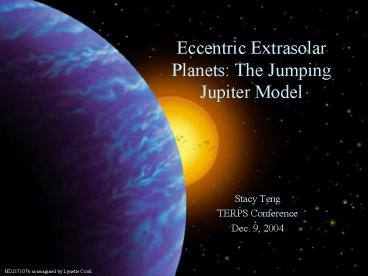Eccentric Extrasolar Planets: The Jumping Jupiter Model PowerPoint PPT Presentation
Title: Eccentric Extrasolar Planets: The Jumping Jupiter Model
1
Eccentric Extrasolar Planets The Jumping Jupiter
Model
- Stacy Teng
- TERPS Conference
- Dec. 9, 2004
HD217107b as imagined by Lynette Cook
2
Background
- Formation of Jupiter and Saturn in our Solar
System - Gradual accumulation of planetesimals into cores
followed by gravitational capture of gaseous
envelopes from the surrounding nebula - Theory needs the giant planets to have formed
beyond the snow line (at 4AU) so volatiles
could condense into ices for capture - Jupiter and Saturn formed on almost circular
orbits as expected for protoplanets evolving from
an accretion disk - See the same thing in other planetary systems?
No!
3
Extrasolar Planets
- Jupiter-mass planets detected by Doppler shift
- Biased toward massive planets with short orbital
periods - Most of the planets detected have semimajor axis
lt 4 AU - What is the formation mechanism of these Hot
Jupiters?
Diagram by Marcy et al., updated March, 2004
4
Formation Theory
- Hot Jupiters formed near the stars Bodenheimer
et al. (2000) - Need to accrete a lot of mass quickly
- Migration tidal coupling Lin et al. (1996)
- Interaction between the planet and the disk to
move the planet inward - Does not explain the large eccentricities that
are observed
5
Formation Theory
- Migration Jumping Jupiter Model
- A system with 3 or more planets
- Encroachment of the Hill spheres as the planets
grow - Numerical simulations
- Systems with 3 planets each with 10-3 Msun
- Planets had various initial separations
- Non-coplanar planets with initial inclinations
0.5, 1, and 1.5 degrees for the inner, middle,
and outer planet - Full tri-dimensional integrations using a mixed
variable symplectic integrator with fixed
stepsize of 20 days
6
Simulation Results
- Result of the simulations
- 1 planet gets ejected from the system
- 1 planet moves to a smaller orbit
- 1 planet migrates further out
- Theory works even for systems with planets formed
within 2 AU
7
Comparison with Observations
- Statistical distribution of eccentricity agrees
well with current data - As the systems evolve, semimajor axis will get
smaller as the orbits get circularized - Future observations should detect distant planets
in systems currently known to have planets
8
References
- Marzari, F. Weidenschilling, S.J., 2002,
Icarus, 156, 570 - Levison, H.F. Duncan, M.J., 1994, Icarus, 108,
18 - http//www.obspm.fr/encycl/pictures.html

